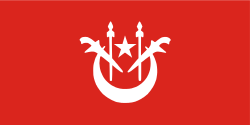Tuanku Bahiyah
| Tuanku Bahiyah | |
|---|---|
|
5th Raja Permaisuri Agong of Malaysia Sultanah of Kedah | |
| Raja Permaisuri Agong of Malaysia | |
| Tenure | 20 September 1970 – 21 September 1975 |
| Installation | 20 February 1971 |
| Predecessor | Tengku Intan Zaharah |
| Successor | Tengku Zainab |
| Sultanah of Kedah | |
| Tenure | 15 July 1958 - 26 August 2003 |
| Installation | 20 February 1959 |
| Successor | Sultanah Haminah Hamidun |
| Born |
24 August 1930 Seri Menanti, Negeri Sembilan |
| Died |
26 August 2003 (aged 73) Istana Kuala Cegar, Alor Setar, Kedah |
| Burial | Kedah Royal Mausoleum in Langgar |
| Spouse | Tuanku Al-Mutassimu Billahi Muhibbuddin Sultan Abdul Halim Muadzam Shah ibni Almarhum Sultan Badlishah |
| Issue |
Dato’ Seri Tunku Intan Shafinaz Dato’ Seri Tunku Soraya Tunku Sarina |
| Father | Tuanku Abdul Rahman ibni Almarhum Tuanku Muhammad |
| Mother | Tunku Kurshiah binti Almarhum Tunku Besar Burhanuddin |
| Religion | Sunni Islam |
Tuanku Bahiyah binti Almarhum Tuanku Abdul Rahman (24 August 1930 – 26 August 2003) was the Sultanah of Kedah (1959–2003) and served as the fifth Raja Permaisuri Agong of Malaysia from 21 September 1970 until 20 September 1975.
Early life
Tuanku Bahiyah was born on 24 August 1930 in Seri Menanti, Negeri Sembilan. She was the eldest daughter of Tuanku Abdul Rahman ibni Almarhum Tuanku Muhammad and Tunku Kurshiah binti Almarhum Tunku Besar Burhanuddin, the Yang di-Pertuan Besar and the Tunku Ampuan Besar of Negeri Sembilan, who were then elected the first Yang di-Pertuan Agong and Raja Permaisuri Agong of Malaysia.
She received her education at a Malay School in Seri Menanti and the Seremban Convent School. She later furthered her studies in United Kingdom and received a degree in Social Science from University of Nottingham.
Marriage
Tuanku Bahiyah married Tuanku Al-Mutassimu Billahi Muhibbudin Sultan Abdul Halim Al-Muadzam Shah ibni Almarhum Sultan Badlishah of Kedah in 1956.
The royal couple had three daughters; two of whom are twins. They are Dato’ Seri Tunku Intan Shafinaz, Dato’ Seri Tunku Soraya and Tunku Sarina (died on 31 August 1991).
Becoming Queen
In 1958, Tuanku Abdul Halim became Sultan of Kedah. Tunku Bahiyah was installed the Sultanah of Kedah with his ascension to the throne.
From 1970, she served her five-year term as Raja Permaisuri Agong or Queen of Malaysia when Tuanku Abdul Halim became the fifth Yang di-Pertuan Agong.
Death
Tuanku Bahiyah died of cancer on 26 August 2003 at Istana Kuala Cegar, Alor Setar.[1] She was buried at the Kedah Royal Mausoleum in Langgar.
Awards and Recognition
Tuanku Bahiyah was conferred various awards, both locally and abroad. In 1970, Emperor Hiroto of Japan awarded her the First Class Order of Sacred Treasure. Later in the same year, President Suharto of Indonesia awarded her the First Class Order of Bintang Maha Putera.
Tuanku Bahiyah was awarded an Honorary Doctorate in Education by the University of Malaya where she served as the Chancellor from 1972 until 1986.
The general hospital in Alor Setar which is also the main referral and tertiary health centre in Northern Peninsular Malaysia was renamed in her honour to Hospital Sultanah Bahiyah.
There is a highway in Alor Setar, Lebuhraya Sultanah Bahiyah (Sultanah Bahiyah Highway) was named after her.
Titles and styles
| Styles of Sultanah Hajah Bahiyah | |
|---|---|
| Reference style | Her Royal Highness |
| Spoken style | Your Royal Highness |
| Alternative style | Maam |
- 24 August 1930 - 9 March 1956: Her Highness (Yang Amat Mulia) Tunku Bahiyah binti Tuanku Abdul Rahman
- 9 March 1956 – 15 July 1958: Her Royal Highness (Duli Yang Teramat Mulia) Tunku Bahiyah binti Tuanku Abdul Rahman, The Raja Puan Muda of Kedah
- 15 July 1958 - 1 September 1960: Her Royal Highness (Kebawah Duli Yang Maha Mulia) Sultanah Bahiyah binti Tuanku Abdul Rahman, The Sultanah of Kedah
- 1 September 1960 - 20 September 1970: Her Royal Highness (Kebawah Duli Yang Maha Mulia) Sultanah Bahiyah binti Almarhum Tuanku Abdul Rahman, The Sultanah of Kedah
- 20 September 1970 – 21 September 1975: Her Majesty (Kebawah Duli Yang Maha Mulia Seri Paduka Baginda) Tuanku Bahiyah binti Almarhum Tuanku Abdul Rahman, The 5th Raja Permaisuri Agong of the Federation
- 21 September 1975 - 26 August 2003: Her Royal Highness (Kebawah Duli Yang Maha Mulia) Sultanah Hajah Bahiyah binti Almarhum Tuanku Abdul Rahman, The Sultanah of Kedah
Social contributions
Tuanku Hajah Bahiyah was the patron of various organisations such as:
- Kedah Orchid Association
- Blood Donors Association of Malaysia
- Family Planning Association of Kedah
- Children’s Welfare Organisation of Kedah
- Islamic Women’s Welfare Organisation of Kedah
- Lioness Club of Kedah
- Netball Association of Kedah
- Women’s Association of Universiti Utara Malaysia (SUTRANITA)
- Nottingham Graduates Association
- Ex-Servicemen Widows and Wives Association (BAKIABAH)
- Kedah Association for the Disabled
- Kedah Thalassaemia Association
- Association of Sultanah Bahiyah Secondary School Students
Honours
See also List of honours of the Kedah Royal Family by country
She has been awarded:[2]
Honours of Kedah
-
.svg.png) Member of the Royal Family Order of Kedah (DK, 29 February 1964)
Member of the Royal Family Order of Kedah (DK, 29 February 1964) -
.svg.png) Member of the Halimi Family Order of Kedah (DKH, 1.1976)
Member of the Halimi Family Order of Kedah (DKH, 1.1976) -
.svg.png) Knight Grand Commander of the Exalted Order of the Crown of Kedah (SPMK, 19 February 1971)
Knight Grand Commander of the Exalted Order of the Crown of Kedah (SPMK, 19 February 1971)
Honours of Malaysia
-
 Malaysia :
Malaysia :
-
_-_DMN.svg.png) Recipient of the Order of the Crown of the Realm (DMN, 19 February 1971)
Recipient of the Order of the Crown of the Realm (DMN, 19 February 1971) -
_-_SMN.svg.png) Grand Commander of the Order of the Defender of the Realm (SMN, 19 February 1959)
Grand Commander of the Order of the Defender of the Realm (SMN, 19 February 1959)
-
-
 Kelantan : Recipient of the Royal Family Order or Star of Yunus (DK)
Kelantan : Recipient of the Royal Family Order or Star of Yunus (DK) -
 Negeri Sembilan : Member of the Royal Family Order of Negeri Sembilan (DKNS, 8.1996)
Negeri Sembilan : Member of the Royal Family Order of Negeri Sembilan (DKNS, 8.1996)
Foreign Honours
-
 Indonesia : 1st Class of the Star of Mahaputera (Bintang Mahaputera Adipurna) (16 March 1970)
Indonesia : 1st Class of the Star of Mahaputera (Bintang Mahaputera Adipurna) (16 March 1970) -
.svg.png) Imperial State of Iran :
Imperial State of Iran :
- 1st class of the Order of the Pleiades (1974)
- Commemorative Medal of the 2500th Anniversary of the founding of the Persian Empire (14 October 1971).[3]
-
 Japan : Dame Grand Cordon of the Order of the Sacred Treasure (29 February 1970)
Japan : Dame Grand Cordon of the Order of the Sacred Treasure (29 February 1970) -
 Thailand : Dame Grand Cross of the Order of Chula Chom Klao (1973)
Thailand : Dame Grand Cross of the Order of Chula Chom Klao (1973)
See also
References
- ↑ "Royal News — August 2003". Retrieved 4 September 2006.
- ↑ The Royal Ark, Kedah genealogical details, p11
- ↑ Badraie
External links
- Tuanku Bahiyah Residential College official site
| Regnal titles | ||
|---|---|---|
| Preceded by Tengku Intan Zaharah (Tengku Ampuan Besar of Terengganu) |
Raja Permaisuri Agong (Queen of Malaysia) |
Succeeded by Tengku Zainab (Raja Perempuan of Kelantan) |